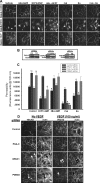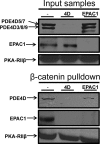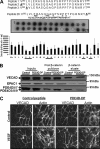Cyclic AMP phosphodiesterase 4D (PDE4D) Tethers EPAC1 in a vascular endothelial cadherin (VE-Cad)-based signaling complex and controls cAMP-mediated vascular permeability
- PMID: 20732872
- PMCID: PMC2962459
- DOI: 10.1074/jbc.M110.140004
Cyclic AMP phosphodiesterase 4D (PDE4D) Tethers EPAC1 in a vascular endothelial cadherin (VE-Cad)-based signaling complex and controls cAMP-mediated vascular permeability
Abstract
Vascular endothelial cell (VEC) permeability is largely dependent on the integrity of vascular endothelial cadherin (VE-cadherin or VE-Cad)-based intercellular adhesions. Activators of protein kinase A (PKA) or of exchange protein activated by cAMP (EPAC) reduce VEC permeability largely by stabilizing VE-Cad-based intercellular adhesions. Currently, little is known concerning the nature and composition of the signaling complexes that allow PKA or EPAC to regulate VE-Cad-based structures and through these actions control permeability. Using pharmacological, biochemical, and cell biological approaches we identified and determined the composition and functionality of a signaling complex that coordinates cAMP-mediated control of VE-Cad-based adhesions and VEC permeability. Thus, we report that PKA, EPAC1, and cyclic nucleotide phosphodiesterase 4D (PDE4D) enzymes integrate into VE-Cad-based signaling complexes in human arterial endothelial cells. Importantly, we show that protein-protein interactions between EPAC1 and PDE4D serve to foster their integration into VE-Cad-based complexes and allow robust local regulation of EPAC1-based stabilization of VE-Cad-based adhesions. Of potential translational importance, we mapped the EPAC1 peptide motif involved in binding PDE4D and show that a cell-permeable variant of this peptide antagonizes EPAC1-PDE4D binding and directly alters VEC permeability. Collectively, our data indicate that PDE4D regulates both the activity and subcellular localization of EPAC1 and identify a novel mechanism for regulated EPAC1 signaling in these cells.
Figures





Similar articles
-
Vascular endothelial-cadherin stabilizes at cell-cell junctions by anchoring to circumferential actin bundles through alpha- and beta-catenins in cyclic AMP-Epac-Rap1 signal-activated endothelial cells.Mol Biol Cell. 2010 Feb 15;21(4):584-96. doi: 10.1091/mbc.e09-07-0580. Epub 2009 Dec 23. Mol Biol Cell. 2010. PMID: 20032304 Free PMC article.
-
Epac1 regulates integrity of endothelial cell junctions through VE-cadherin.FEBS Lett. 2005 Sep 12;579(22):4966-72. doi: 10.1016/j.febslet.2005.07.080. FEBS Lett. 2005. PMID: 16115630
-
Adaptive phenotypic modulation of human arterial endothelial cells to fluid shear stress-encoded signals: modulation by phosphodiesterase 4D-VE-cadherin signalling.Cell Signal. 2016 Jul;28(7):741-8. doi: 10.1016/j.cellsig.2015.12.001. Epub 2015 Dec 4. Cell Signal. 2016. PMID: 26658094
-
Dynamic Regulation of Vascular Permeability by Vascular Endothelial Cadherin-Mediated Endothelial Cell-Cell Junctions.J Nippon Med Sch. 2017;84(4):148-159. doi: 10.1272/jnms.84.148. J Nippon Med Sch. 2017. PMID: 28978894 Review.
-
Regulation of the inflammatory response of vascular endothelial cells by EPAC1.Br J Pharmacol. 2012 May;166(2):434-46. doi: 10.1111/j.1476-5381.2011.01808.x. Br J Pharmacol. 2012. PMID: 22145651 Free PMC article. Review.
Cited by
-
Increased microvascular permeability in mice lacking Epac1 (Rapgef3).Acta Physiol (Oxf). 2017 Feb;219(2):441-452. doi: 10.1111/apha.12697. Epub 2016 May 17. Acta Physiol (Oxf). 2017. PMID: 27096875 Free PMC article.
-
Exploration of the shared gene signatures and molecular mechanisms between Alzheimer's disease and intracranial aneurysm.Sci Rep. 2024 Oct 19;14(1):24628. doi: 10.1038/s41598-024-75694-6. Sci Rep. 2024. PMID: 39427050 Free PMC article.
-
Monogenic, Polygenic, and MicroRNA Markers for Ischemic Stroke.Mol Neurobiol. 2019 Feb;56(2):1330-1343. doi: 10.1007/s12035-018-1055-3. Epub 2018 Jun 8. Mol Neurobiol. 2019. PMID: 29948938 Free PMC article. Review.
-
PKA compartmentalization via AKAP220 and AKAP12 contributes to endothelial barrier regulation.PLoS One. 2014 Sep 4;9(9):e106733. doi: 10.1371/journal.pone.0106733. eCollection 2014. PLoS One. 2014. PMID: 25188285 Free PMC article.
-
cAMP signalling protects proximal tubular epithelial cells from cisplatin-induced apoptosis via activation of Epac.Br J Pharmacol. 2012 Feb;165(4b):1137-50. doi: 10.1111/j.1476-5381.2011.01594.x. Br J Pharmacol. 2012. PMID: 21745194 Free PMC article.
References
-
- Dejana E., Tournier-Lasserve E., Weinstein B. M. (2009) Dev. Cell 16, 209–221 - PubMed
-
- Vestweber D. (2008) Arterioscler. Thromb. Vasc. Biol. 28, 223–232 - PubMed
-
- Galan Moya E. M., Le Guelte A., Gavard J. (2009) Cell. Signal. 21, 1727–1737 - PubMed
-
- Gavard J. (2009) FEBS Lett. 583, 1–6 - PubMed
-
- Tan W., Palmby T. R., Gavard J., Amornphimoltham P., Zheng Y., Gutkind J. S. (2008) FASEB J. 22, 1829–1838 - PubMed
Publication types
MeSH terms
Substances
Grants and funding
LinkOut - more resources
Full Text Sources
Other Literature Sources
Miscellaneous

